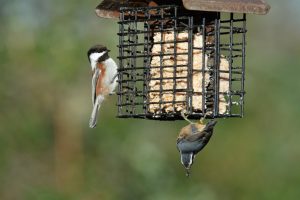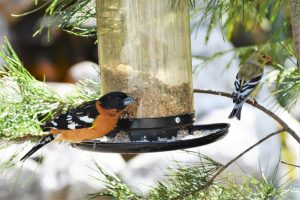 According to surveys by the U.S. Fish & Wildlife Service, bird watching is second only to gardening as our favorite outdoor pastime. It even outranks hunting and fishing. These surveys reveal that 47 million of us over the age of 16 are bird watchers. We buy a hundred million tons of bird seed every year. And bird watching as a business generates $107 billion in annual revenues for the U.S. In Washington State alone, wildlife viewing and related photography add nearly $7.5 billion to state and local economies.
According to surveys by the U.S. Fish & Wildlife Service, bird watching is second only to gardening as our favorite outdoor pastime. It even outranks hunting and fishing. These surveys reveal that 47 million of us over the age of 16 are bird watchers. We buy a hundred million tons of bird seed every year. And bird watching as a business generates $107 billion in annual revenues for the U.S. In Washington State alone, wildlife viewing and related photography add nearly $7.5 billion to state and local economies.
As one of America’s fastest growing hobbies, bird watching can be enjoyed by all ages and abilities, from shut-ins to families with small children to those who travel the globe to add new birds to their life lists.
March may seem early for migrating birds, but resourceful males know that the early bird gets not only the worm but also the best nest sites. A prime location, plus gorgeous plumage and a seductive song, can make them irresistible to arriving females. But the siren song of spring is also a signal that it’s time to get those bird houses and feeders ready for the coming waves of northbound birds. With bird houses, it’s important to make sure dimensions such as hole size are suitable for the species you hope to attract. Chickadees don’t want to trust the safety of their families to nest cavities easily invaded by bigger birds, such as European Starlings. The Internet offers many good web sites with tips and detailed plans for selecting, building and placing bird houses. The Cornell Lab of Ornithology website allaboutbirds.org is an excellent place to start. It also has a wealth of other information about birds, including recordings of their songs.
 Of course bird feeders need to be kept clean and safe in every season of the year. Well maintained bird feeders that are kept stocked with fresh, uncontaminated sunflower seed, niger seed or suet can attract a colorful parade of backyard birds, both year-round residents and those that make seasonal appearances along our Pacific flyway. Spring migration can be a visual feast. You never know what you’re going to see next.
Of course bird feeders need to be kept clean and safe in every season of the year. Well maintained bird feeders that are kept stocked with fresh, uncontaminated sunflower seed, niger seed or suet can attract a colorful parade of backyard birds, both year-round residents and those that make seasonal appearances along our Pacific flyway. Spring migration can be a visual feast. You never know what you’re going to see next.
Perches and feeding surfaces should be scrubbed and sanitized regularly. You can use a 10% bleach solution and follow it with a clean-water flush. Feeders should be placed close enough to shrubs, trees or other protective cover that birds can quickly dash to safety when they are targeted by predatory hawks. But feeders should not be so close that cats can use the cover to ambush unwary birds. Outdoor cats kill billions of birds every year.
As our most visible and accessible wildlife neighbors, birds can be a source of endless fascination and enjoyment as we watch, feed and listen to their delightful spring chorus.
Article courtesy Gene Bullock. Gene has been writing a monthly column for the past five years that appears in six Kitsap weekly newspapers as a promotion for Kitsap Audubon. He is the Newsletter Editor and Education Chair for the Kitsap Audubon Society. Photos courtesy Carrie Griffis. Chestnut-backed Chickadees and Red-breasted Nuthatches are among the diverse variety of birds attracted to backyard see and suet feeders. Black-headed Grosbeaks are easily attracted with sunflower seeds.







